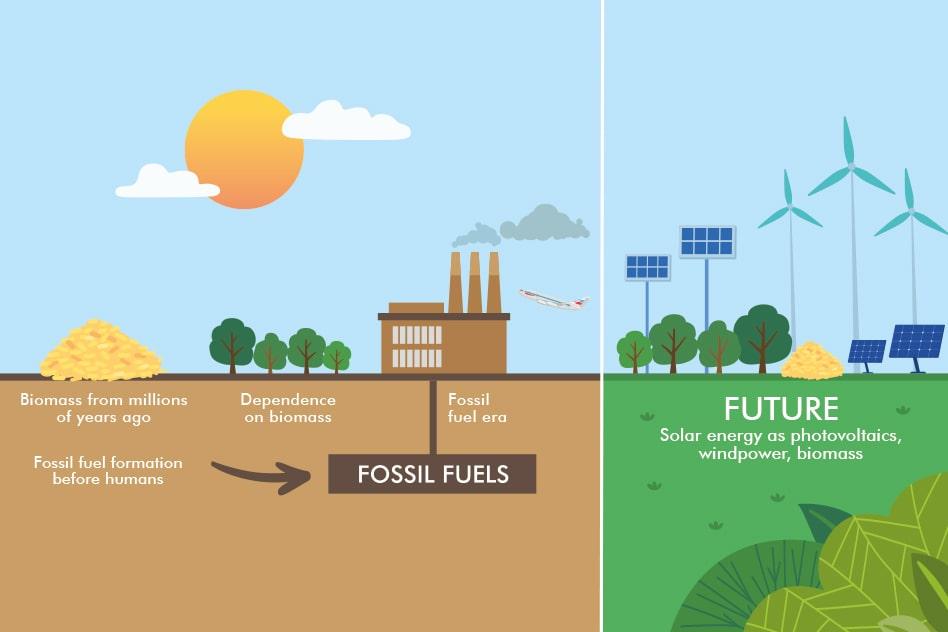Renewable energy sources are becoming increasingly popular due to their positive impact on the environment and cost-effectiveness. In the coming years, the future of energy is likely to be dominated by renewable sources such as solar, wind, hydro, and geothermal energy.
These sources are plentiful, sustainable and help reduce greenhouse gas emissions. The shift to renewable energy is driven by concerns about energy security and climate change, and governments and businesses are actively investing in renewable projects. This article will explore the future of energy and how renewable sources will continue to shape the energy landscape.

Credit: www.routledge.com
Solar Energy
Explanation Of Solar Energy As A Renewable Source
Solar energy is renewable energy generated from the sun’s radiation. It is a clean, abundant, and virtually inexhaustible source of power, unlike fossil fuels. Unlike traditional energy sources, solar energy does not emit any pollutants that harm the environment and human health.
Solar panels collect sunlight and convert it into electricity, or absorbed for space heating and water heating purposes.
Advantages And Disadvantages Of Solar Energy
Advantages:
- Solar energy is abundant, clean, and renewable
- Solar power systems are durable and require minimal maintenance
- Solar panels are versatile and can be installed in remote locations
- Solar energy systems can reduce electricity bills and energy costs
- Solar energy is sustainable and does not contribute to climate change
Disadvantages:
- Solar energy is intermittent due to changes in weather and time of day
- Solar panels require significant upfront costs and have a long roi
- Solar panels take up a lot of space and may not be suitable for every rooftop
- Energy storage systems can be expensive and require regular maintenance
- Production of solar panels can have negative environmental impacts
Different Types Of Solar Energy Systems
There are various types of solar energy systems available, including:
- Photovoltaic (pv) panels: Converts sunlight directly into electricity.
- Concentrated solar power (csp) systems: Use mirrors or lenses to focus sunlight onto a small area, which heats a fluid that is used to power a turbine and generate electricity.
- Solar water heaters: Use sunlight to heat water for domestic or commercial use.
- Off-grid solar power systems: Provides electricity to buildings or areas that are not connected to the main power grid.
Case Studies Of Successful Solar Energy Projects
- Anheuser-busch inbev installed a 2.6 mw solar array in their fairfield, california brewery, significantly decreasing their carbon footprint.
- Tesla installed a 55,000 panel solar farm on the island of ta’u in american samoa, providing reliable electricity to the island’s 600 residents.
- The w hotel in washington d.c. Installed a 12,000 square foot solar panel system on its rooftop, providing up to 20% of the hotel’s electricity needs.
Future Prospects For Solar Energy
The future of solar energy is bright. Technological advancements are driving down the cost of solar panels and increasing efficiency. As solar energy systems become more accessible and sustainable, more businesses and households are adopting the technology. Solar energy has the potential to become the leading source of power in the world, contributing to a more sustainable future.
Harnessing Wind Energy
Renewable energy is an emerging sector with seemingly endless possibilities, and wind energy is one of the most promising and rapidly expanding sources. It involves the utilization of wind turbines to convert wind energy into electrical energy. This sustainable method of energy generation is gaining popularity as the world becomes more environmentally conscious.
We will explore the intricacies of harnessing wind energy to power our future world.
Introduction To Wind Energy As A Renewable Source
Wind energy is a clean and renewable source of energy. It’s no wonder that it’s becoming increasingly popular as power companies and countries look for ways to reduce emissions and tackle climate change. Wind turbines harness the kinetic energy of wind to produce electricity.
There are two types of wind turbines: onshore and offshore.
Pros And Cons Of Using Wind Turbines For Energy Generation
Like any other energy generation method, wind turbines come with their advantages and disadvantages. Here are some pros and cons of using wind turbines for energy generation:
**pros**
- Wind energy is clean, renewable and sustainable.
- Wind turbines have minimal greenhouse gas emissions and reduce dependence on fossil fuels.
- Turbines have a long lifespan, up to 25 years, and require less maintenance compared to traditional power generators.
- Wind turbines can be built in rural areas, leveraging large tracts of unused lands.
- Wind energy can be used to energize remote locations that are not connected to the electricity grid.
**cons**
- Wind turbines can be noisy, and the noise can be a nuisance to people living near them.
- They can also impact wildlife and alter ecosystems.
- Wind turbines require a steady flow of wind to produce significant amounts of energy.
- Wind turbines can be costly to set up and maintain, especially the offshore ones.
Comparison Of Onshore And Offshore Wind Turbines
Both onshore and offshore wind turbines generate energy using the same technology, but they have differences in their cost, efficiency, and practicality. Here’s a summary of the comparison:
**onshore wind turbines**
- Cheaper to install compared to offshore wind turbines.
- Less efficient than offshore turbines due to less consistent wind flow.
- More vulnerable to vandalism and theft.
- Easier to maintain and repair, leading to lower maintenance costs.
**offshore wind turbines**
- More efficient than onshore turbines due to better wind flow and larger blade size.
- More costly and challenging to install than onshore turbines.
- More resistant to vandalism and theft.
- More challenging to maintain and repair because of the offshore location.
Government Incentives For Wind Energy
Governments worldwide recognize the potential of wind energy to help alleviate the challenges we face in the energy sector. As a result, many countries offer incentives to promote the development and use of wind energy. These incentives include tax credits, feed-in tariffs, and production incentives.
They aim to reduce the costs of developing, installing, and operating wind turbines and encourage investment in renewable energy.
Case Studies Of Successful Wind Energy Projects
Many projects worldwide aim to capitalize on the wind’s potential to produce electricity. Here are some of the successful wind energy projects:
- Walney extension offshore wind farm in the uk, which has 87 wind turbines and can produce enough electricity for over 590,000 homes.
- Jiuquan wind power base in china, which has over 7,000 wind turbines and contributes over 20 gw of power to the chinese electricity grid.
- Horns rev 3 offshore wind farm in denmark, which has 49 wind turbines with installed capacity of 406.7 mw and produces enough energy to power 425,000 homes.
Environmental Impact Assessment Of Wind Turbines
As with any activity that alters the environment, wind turbines have an impact on ecosystems, wildlife, and the environment. Governments and regulatory bodies require an environmental impact assessment (eia) to assess any potential impacts and manage them effectively. An eia will assess the wind farm’s potential impact on wildlife, including migratory birds, and on the surrounding landscape, such as noise pollution and the visual impact of the turbines.
Wind energy is an important and growing source of clean and renewable energy. Wind turbines have both advantages and disadvantages, with offshore and onshore turbines having their unique pros and cons. Governments must continue to offer incentives to promote the development of wind energy projects, and the eia process must be followed to minimize the environmental impact of these projects.
With the world’s growing demand for energy and the need for a drastic reduction in carbon emissions, wind energy has a significant role to play in our sustainable future.
Hydroelectric Power
Explanation Of The Concept Of Hydroelectric Power
Hydroelectric power is an energy source that is generated by the movement of water. It involves the conversion of the kinetic energy of moving water into electricity using a hydroelectric dam. The dam captures the energy of flowing water and uses it to rotate the turbine, which then generates electricity.
This renewable energy source is used worldwide because it doesn’t produce air pollution, unlike other non-renewable energy sources.
Advantages And Disadvantages Of Hydroelectric Power
Hydroelectric power has several advantages and disadvantages.
Advantages:
- It is a renewable energy source and does not produce harmful emissions.
- It is highly efficient as hydroelectric turbines achieve up to 95% efficiency, making it one of the most effective renewable sources of energy.
- It is a flexible energy source that can quickly supplement electricity production during peak consumption periods.
- Hydroelectric power systems can last up to 100 years, making it a long-lasting and reliable energy source.
Disadvantages:
- Environmental concerns such as fish mortality and water-flow depletion, which affects the local ecosystem.
- Costly initial investments for construction and setting up the infrastructure for hydroelectric power systems.
- Dependence on available water levels and suitable terrain, which can limit its availability in certain regions.
- Unforeseen natural disasters like floods can damage dams, causing power outages and infrastructure damage.
Different Types Of Hydroelectric Power Systems
There are different types of hydroelectric power systems, including:
- Impoundment systems, which involve a dam being built on a river that creates a storage reservoir where water is stored before it is released to generate electricity.
- Run-of-the-river systems, which don’t require dams and utilize the natural flow of water in a river to generate electricity without interrupting stream flow.
- Pumped storage systems, which use excess energy to pump water from a lower reservoir to an upper one. The water is then released from the upper reservoir to generate electricity when demand is high.
Prospects For Large-Scale Hydroelectric Power Projects
Large-scale hydroelectric power projects have been successful in the past and continue to be viable in several regions, especially in developing countries that require massive power production. Hydroelectric dams can generate large amounts of electricity, providing enough energy to power entire cities, but they require massive infrastructure investments.
However, they are not suitable to all regions and geographies due to environmental concerns.
Environmental Impact Of Hydroelectric Dams And The Shift Towards Smaller-Scale Hydroelectricity
Large-scale hydroelectric dams often cause significant environmental damage, including habitat destruction, soil erosion, and the displacement of indigenous communities. As a result, there has been a shift towards smaller-scale hydroelectricity systems, which have significantly less environmental impact and can often be more convenient for small communities.
Focusing on small hydroelectric power systems, which generate energy on a community scale, could lead to sustainable energy production that doesn’t destroy ecosystems.
Biomass Energy
The world’s population is growing at an unprecedented rate, and as energy demands continue to escalate, the search for sustainable, reliable, and affordable sources of energy become more crucial than ever before. , derived from biological material like crops, wood, and organic waste, has the potential to satisfy our energy demands while minimizing the impact on the environment.
Introduction To Biomass Energy
Biomass energy is renewable energy produced from organic material, including biodegradable waste, crops, and residues. This energy source is reliant on natural photosynthesis, which converts solar energy into carbon dioxide, oxygen, and biomass. With almost no carbon footprint left, biomass energy has become an attractive option in the quest for sustainable energy.
Pros And Cons Of Using Biomass Energy
Pros:
- Environmentally friendly: Biomass energy is virtually carbon neutral as the co2 produced during the combustion of biomass is absorbed by plants through photosynthesis.
- Cost-effective: Biomass is usually cheaper than fossil fuels, making it an affordable and sustainable source of energy.
- Security: We can keep producing biomass energy as long as plants and organic matter are there.
- Job creation: The use of biomass opens up job opportunities in the agricultural sector, forestry, and waste management.
Cons:
- Limited efficiency: Biomass energy’s yield is lower than that of fossil fuels, which means larger quantities of biomass are required to generate the same amount of energy.
- Pollution: Burning biomass to generate energy generates pollutants like nitrogen oxides, sulphur dioxide, and particulate matter which aren’t good for human health.
- Fossil fuels used in production: The production of biomass energy often requires the use of fossil fuels, which contravenes the primary aim of creating a carbon-neutral future.
Different Sources Of Biomass Energy
Biomass Energy Sources Include
- Wood and forestry waste
- Crop waste like corn stover and sugarcane bagasse
- Animal waste such as manure and chicken litter
- Municipal solid waste and sewage sludge
Future Prospects Of Biomass Energy
The future of biomass energy is promising as a sustainable energy source, but this will be dependent on the continued exploration and refinement of biomass technologies. With the increasing demand for renewable energy, biomass-based power generation could rise from 73 gw in 2018 to 88gw by 2028, representing a cagr of 1.
8%.
Case Studies Of Successful Biomass Energy Projects
- Arensis (california-based energy company) launched a biomass energy power plant that generates 172,000 mwh of electricity annually.
- Nagano prefecture in japan created a biomass plant that generates electricity using annual waste products from the agricultural industry.
- The sleaford renewable energy plant in the uk generates renewable electricity using straw biogas and has an output capacity of 38mw.
Biomass energy is an excellent option to meet the growing energy demands and reduce greenhouse gas emissions. As we push for sustainable energy solutions, biomass energy is set to play an essential role in the future of energy production.
Frequently Asked Questions On The Future Of Energy: Exploring Renewable Sources And Their Impact
How Does Renewable Energy Work?
Renewable energy comes from naturally replenishing resources: sunlight, wind, water, and geothermal heat.
What Are The Benefits Of Renewable Energy?
Renewable energy reduces greenhouse gas emissions, creates jobs, and supports local economies.
Is Renewable Energy Affordable For Consumers?
Yes, with advances in technology, the cost of renewable energy has decreased significantly, making it affordable for consumers.
Conclusion
As we continue to seek out sustainable solutions for our energy needs, renewable sources are becoming increasingly important. While there are some challenges to overcome, the future looks bright for renewable energy. Whether it’s solar, wind, hydropower, or something else entirely, there are a wide range of options available that can help us reduce our reliance on fossil fuels and move towards a cleaner, more sustainable energy future.
As technology continues to advance and society becomes more conscious of the impact we have on the environment, we can expect to see continued growth in the renewable energy sector. By investing in renewable energy today, we can help create a more sustainable future for ourselves and for generations to come.
So let’s continue exploring the possibilities and working towards a cleaner, brighter future for all.

